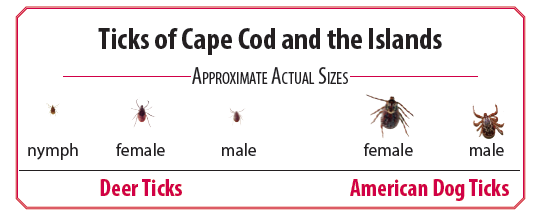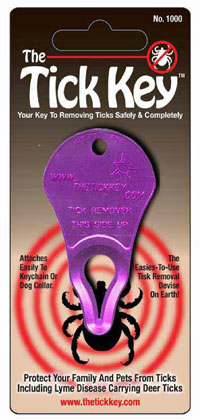Spring has arrived , and with the warm weather comes the start of the tick season, surely to be followed by an increase in the number of cases of Lyme disease on Cape Cod.
Lyme disease was discovered back in the 1970’s when a large number of the residents of Lyme Connecticut came down with a mysterious illness. It was discovered that the illness
was caused by the tick-borne bacterium (Borrelia burgdorferi), carried by the deer tick.
In the years since, the disease has spread across much of the country. Lyme disease on Cape Cod has reached near epidemic proportions, with Nantucket being called the Lyme capitol of the world.
About The Deer Tick

Deer ticks have a three-stage life cycle. The adult tick is active in the late fall and early spring while the larvae and nymphs are active during the late spring, early summer and fall.
The adult tick is a dark reddish brown and the size of a sesame seed. The nymphs are smaller, and are difficult to see. The larvae are the size of a period.
Adult ticks feed and mate on large mammals such as deer, pets, or humans in the fall and early spring.
Female ticks drop off and lay eggs on the ground in the spring. Miniscule larvae hatch and feed upon white-footed mice, other small mammals or even birds. If the host mammal is infected with Lyme disease bacteria, then deer tick larvae will become infected. After feeding, larvae become inactive until early spring when they molt into the nymph stage.
Nymphs that have picked up the bacteria in the larval stage are capable of transmitting the bacteria to humans or other hosts, including pets. This stage is most active in June, and causes more cases of Lyme disease than the adult tick.
Nymphs seek a host for a blood meal in the late spring and summer. The host may be a small mammal or bird, but may also be a dog, cat, or human.
After feeding, nymphs molt into the adult stage. Adult ticks start the cycle over by feeding on a large mammal such as a deer, pet, or human.
Note that both infected nymph and adult ticks can transmit the Lyme disease bacteria.
The main host for the deer tick is the whitetail deer. Numerous studies have shown that keeping the deer population at acceptable levels dramatically reduces the incidence of Lyme disease.
Some areas of Connecticut, where Lyme disease had reached epidemic proportions, virtually eliminated the disease by reducing the deer population from 30 per square mile to 3 per square mile.
Controlling the deer population is one of the keys to reducing the cases of Lyme disease on Cape cod
How to protect yourself from Lyme disease on Cape Cod.
Deer ticks are usually found in woodland habitats such as hiking trails, conservation lands and other forested recreational areas.
However, they can be found right in your own backyard.
You can protect yourself by following a few simple steps.
- Wear light colored clothing. Ticks are easier to see against a light background.
- Wear long sleeves and long pants. Tuck your pants into your shoes.
- Use insect repellents containing deet. Follow manufacturers instructions.
- Use veterinarian-approved tick control products on pets that are allowed outdoors.
- Keep brush and tall vegetation away from the house.
- Keep bird feeders at a distance as birds may carry ticks.
- Do a tick check everyday.
A careful tick check is the most effective way to protect you and your family from Lyme disease.
After outdoor activities, brush off clothing thoroughly and do a visual inspection paying particular attention to folded areas such as cuffs, belts and shirt collars.
Do a complete body check on a daily basis. Check children more frequently. Carefully inspect the hairline and scalp as well as difficult-to-see areas such as the back.
A tick needs to be feeding on a host for at least 24 hours in order to transmit the bacteria. Therefore, a daily tick check is imperative to prevent this debilitating illness.
The right way to remove a tick
Proper tick removal is a key ingredient to preventing Lyme disease. There is an innovative new tool on the market which makes tick removal very simple. The tick key is the only tick removal method proven effective 99.9% of the time. Every home should have one of these.
After removal, apply an antiseptic to the bite.
According to the CDC, you should not apply petroleum jelly, nail polish remover, or a hot match to the tick.
These methods do not work.
For proper identification, place the tick in a vial or small bottle and bring or send to:
Cape Cod Cooperative Extension
P.O. Box 367, Deeds and Probate Bldg.
Railroad Ave, Barnstable, MA 02630
By taking a few simple precautions you can protect yourself and your family from Lyme disease on Cape Cod.
